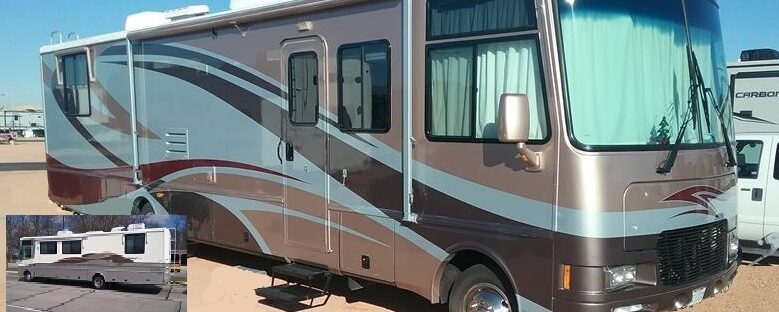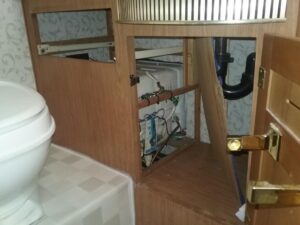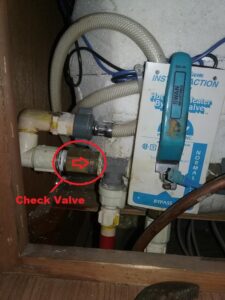When winterizing last year, I knew my bypass check-valve was bad, as I was getting a lot of antifreeze in the water heater while pumping antifreeze through the system. Before winterizing this year, its time to change the check valve. A new one can be had for less than $10 through Amazon. or you can install a manual valve instead, this is what I did. My logic is, the check valve restricts flow and is also prone to failure. With the manual valve, I get full flow, and its not going to fail. Cost for either option is about the same.
On my 99 Southwind, the winterization valve is located beside the water heater, under the sink countertop, I needed to remove a panel from inside the cabinet to get to it.
Many RVs use three manually operated valves to do the water heater bypass but Fleetwood used one manual valve and a check valve. The photo shows the winterize valve in the “BYPASS mode. In this position, cold water enters the valve from the bottom but instead of going to the right and entering the water heater, it turns left where it flows back out through the hot water pipes, effectively bypassing the water heater. Water is prevented from flowing backwards and into the water heater from the hot water hose by a one way check valve. Water can only flow from left to right through the check valve, so it prevents water from flowing back into the water heater.
In the NORMAL position, cold water would enter the valve from the bottom and turn right. It then flows through a hose that connects to the water heaters cold supply.. Hot water would exit the water heater through another hose, flow through the check valve, then turn right and down to supply the hot water pipes.
There are two problems that a faulty check valve can produce. It can restrict the flow of hot water, i.e. great flow when the cold faucet is on but a reduced flow from the hot water faucet.. The other problem is it can allow flow in both directions. This isn’t a problem until you attempt to winterize, and find the water tank is filling up with antifreeze. This is the problem I was having. When the winterization valve is in bypass mode, the check valve should prevent water from flowing backwards and entering the water heater from the hot water out connection.
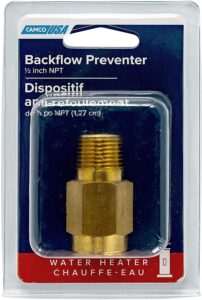
The Winterization bypass valve on my Southwind is cleverly hidden behind a panel under the bathroom sink. I’m not sure exactly how this was originally set up, but the panel isn’t secured, it just kind of moves out of the way. Replacing the check valve is a fairly easy task but with risks. The risk is breaking 20 year old plastic pipes and fittings. I was very careful taking mine apart as not to apply stress on any of the plastic fittings. Keep track of the rubber washers that go inside the hose type fittings, these may stick to the plastic fitting and not stay inside the hose. I used thread seal paste when I reassembled. Verify the rubber bushings are inside the hose fitting before installing, otherwise it won’t seal without it (I know) 🙂
There are two approaches to this problem:
1) Replace the check valve with a new check valve.
2) Replace the check valve with a manual valve. This is what I did.
I needed a new ball valve with 1/2 FIP connections on both ends. I then used a 18 inch long hose that also had 1/2 FIP connections on both ends. I basically plumbed the manual valve in where the original check valve was
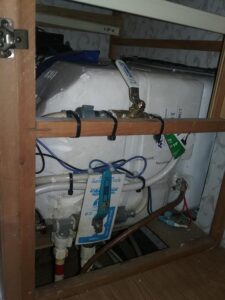 Valves shown in BYPASS mode. Notice the new manual valves is closed so that it blocks flow.
Valves shown in BYPASS mode. Notice the new manual valves is closed so that it blocks flow.
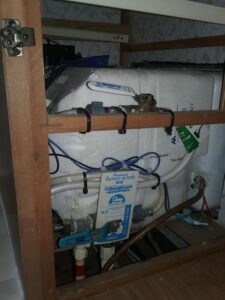 Valves shown in NORMAL mode. The new manual valve is open and supplies normal flow.
Valves shown in NORMAL mode. The new manual valve is open and supplies normal flow.
After installing a new manual valve, I was able to winterize with no problem using three gallons of fluid. This is the procedure I use, CLICK HERE
Although I drain the water heater, I still like to get some antifreeze inside of it just in case there is any water pooling in the bottom. With the drain plug removed, I place the winterize valve in the NORMAL position. I then turn the pump ON, (sucking antifreeze out of the jug). When I see nice pink fluid coming out of the drain, then I tun the pump back off, reinsert the drain, and place the valve back in the winterize mode.
